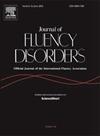A phenomenological exploration of the contextual variability of stuttering
IF 2.1
3区 医学
Q1 AUDIOLOGY & SPEECH-LANGUAGE PATHOLOGY
引用次数: 0
Abstract
Purpose
It is well documented that stuttering is contextually variable, as its frequency and duration can vary widely across contexts and emerge from interactions across internal and external factors (i.e., corresponding to the speaker and communication contexts in which a speaker may find themselves, respectively). While much of the previous literature has described contextual variability from listeners' vantage points, there is scant research capturing speaker-centered perspectives. As such, this study explored the beliefs and experiences of 10 people who stutter (PWS) regarding: a) how their stuttering varies; b) potential contributors to its variability; and c) how stuttering variability can impact quality of life.
Methods
Ten PWS participated in phenomenological interviews to discuss their lived experiences of stuttering. Analyses of interviews yielded experiential themes and corresponding subthemes encompassing unique and shared insights across participants.
Results
Participants' depictions of contextual variability revealed four broad experiential themes: "randomness and cyclical patterns of stuttering," "internal state factors," "specific cues," and "perceived judgment within social contexts."
Conclusion
The current investigation highlighted various factors that participants felt were associated with stuttering variability based on their lived experiences. Notably, alignment of several findings (e.g., saliency of perceived judgement) with previous conceptualizations of stuttering variability (e.g., concern for social approval) yielded descriptions grounded within speakers’ perspectives that contextualized prevailing (i.e., listener-oriented) narratives of stuttering which have been historically dominant across therapy and research. Thus, results from the present study underscored the vital importance of accounting for lived experiences to advance our current understanding of stuttering and contextual variability.
结巴语境变异性的现象学探索
有充分的证据表明,口吃是环境变量,因为它的频率和持续时间可以在不同的语境中有很大的不同,并且是由内部和外部因素的相互作用产生的(即,分别对应于说话者和说话者可能发现自己的交际语境)。虽然之前的许多文献都是从听者的角度来描述语境变化,但很少有研究从说话者的角度来描述语境变化。因此,本研究探讨了10名口吃者(PWS)的信念和经历:a)他们的口吃如何变化;B)其变异性的潜在贡献者;c)口吃的可变性如何影响生活质量。方法采用现象学访谈法对10名口吃患者进行口吃生活经历调查。对访谈的分析产生了经验主题和相应的子主题,其中包含了参与者之间独特和共享的见解。结果:参与者对情境可变性的描述揭示了四个广泛的经验主题:“口吃的随机性和周期性模式”、“内部状态因素”、“特定线索”和“社会情境中的感知判断”。结论当前的调查强调了参与者认为与他们的生活经历有关的口吃变异性的各种因素。值得注意的是,一些研究结果(例如,感知判断的显著性)与先前对口吃变异性的概念化(例如,对社会认可的关注)相一致,产生了基于说话者视角的描述,这些描述将在治疗和研究中历史上占主导地位的口吃叙事语境化(例如,以听众为导向)。因此,本研究的结果强调了生活经历的重要性,以促进我们目前对口吃和环境变化的理解。
本文章由计算机程序翻译,如有差异,请以英文原文为准。
求助全文
约1分钟内获得全文
求助全文
来源期刊

Journal of Fluency Disorders
AUDIOLOGY & SPEECH-LANGUAGE PATHOLOGY-REHABILITATION
CiteScore
3.70
自引率
14.30%
发文量
23
审稿时长
>12 weeks
期刊介绍:
Journal of Fluency Disorders provides comprehensive coverage of clinical, experimental, and theoretical aspects of stuttering, including the latest remediation techniques. As the official journal of the International Fluency Association, the journal features full-length research and clinical reports; methodological, theoretical and philosophical articles; reviews; short communications and much more – all readily accessible and tailored to the needs of the professional.
 求助内容:
求助内容: 应助结果提醒方式:
应助结果提醒方式:


